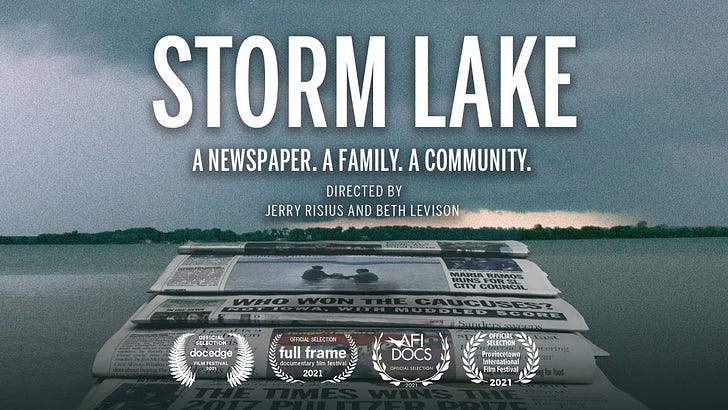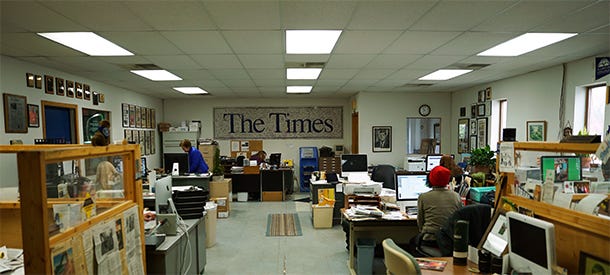Storm Lake
This documentary about a tiny newspaper has big things to say about the importance of journalism and free expression in American society.
This review is free content for everyone. Please consider supporting Film Yap with a modest subscription to keep reading reviews like this.
“Storm Lake” combines two things I love: journalism and movies.
My first newspaper office was in a former storage warehouse used for paint, and the bouquet of turpentine still clung to it. When they hired me, they doubled the reporting staff from one to two. We didn’t even have a newsroom per se, our desks lining the hallway that led to the sales department.
Our paper came out once a week, and all the workers were expected to fill their trunks with stacks and drop them off at stores, city hall, VFW halls, etc. We published stories about what the city council and the school board were up to, but also fairs and 4-H awards and Veteran’s Day ceremonies.
It mattered to us, and to the people who read it. We started doing a second edition per week, then three, then five and by the time I left, it had gone from a free weekly to a paid daily newspaper, seven days a week.
It was the sort of place a lot of people start their journalism career, hoping to leave as soon as you can. You move on to bigger papers and bigger stories, and start to talk derisively about the stuff you used to write about — “chicken dinner stories,” we called them, the idea being that just because some people get together for a chicken dinner doesn’t make it news.
“Storm Lake,” a new documentary directed by Beth Levison and Jerry Risius, is about a paper where the people never left, and readers never tire of the chicken dinner stories.
The Storm Lake Times is a weekly paper in western Iowa serving a farming community. It’s family-owned and run, with a circulation of 3,000. The filmmakers followed the journalists around for the better part of a year, through the 2020 Iowa caucus and the early part of the pandemic.
Art Cullen is the owner and editor, taking local and state politicians to task in his biting columns for 40 years. He sort of looks like Mark Twain with his glasses, lanky frame and white mop of hair.
In 2017 he won a Pulitzer Prize for editorial writing — almost unheard of for industry awards that usually only acknowledge the Washington Posts and New York Timeses. He’s a firebrand Democrat in a largely Republican county, so the prize actually cost him subscribers.
His wife, Dolores, is the features writer, scouring the little farming towns to find the Tyson factory worker who made it to the semifinals on a Spanish-language singing show or the state pork industry queen visiting a school. Son Tom handles most of the politics and news reporting, the heir apparent who’s always getting barked at by his dad asking when the latest story will be finished. Brother John runs the business side of things, though he’s officially retired on Social Security and doesn’t take a salary anymore.
Everybody takes notes by hand and their own photographs. Their office is a corrugated steel block that doesn’t look too different from my paint warehouse. The family dog, Peaches, ambles around the newsroom to find the best spots for dozing.
It’s glorious.
In this day the Times is essentially a miracle: a small-town newspaper making a difference and getting by — John is ecstatic about the $2,000 profit they pulled last year — in a time when hundreds of papers have shuttered their doors or winnowed their staffs down to the bone, and then started casting off parts of the skeleton.
(How bad? Here’re some real-life numbers: When I joined The Indianapolis Star in 2005, the news staff tallied nearly 300 people including specialty publications. Today it’s about 60. My old paper in Florida, the Ocala Star-Banner, had 60 journalists when I left; now it’s five.)
The film follows Art and the gang around as they cover events small and large, from the effect of March rains on the corn crop to hosting presidential contenders Elizabeth Warren and Pete Buttigieg when they come through town to press the flesh.
The highlight is the caucuses, when little Iowa communities turn up in the national spotlight every four years. Art even makes appearances on CNN and MSNBC to supply some homespun wisdom on Iowa politics as it’s practiced at the micro level.
Storm Lake has changed a lot with a huge influx of immigrants to work in the meat factories — many of them illegally. Art and the Times make no bones about being in their corner, and the opposite of whatever one Trump is in. It causes friction in their red-tinged community, but the GOP readers have learned to skip the editorial page and get to the local news.
Challenges await around every corner. The single ad saleswoman treks door to door to the main street shops, hoping to scrounge up a hundred bucks from business people who are barely getting by themselves. John made the tough decision to cut the TV listings from 80 channels down to 31 to save $10,000 a year on printing costs.
But the Cullen clan believes with every fiber that if they produce good journalism that matters to the people in these tiny communities, they will reward you with their eyeballs and attention. So far, it’s worked out.
“Storm Lake” is a top-drawer documentary that takes an old fashioned fly-on-the-wall approach. You won’t hear the filmmakers chiming in or asking their subjects to pontificate on ‘what it’s all about.’ We simply see, and understand.
Just as newspapers are under threat these days, so is the documentary form — at least in my view, and those others who think it’s being rapidly taken over by propagandists who are simply hammering a particular point of view… and shading the truth while doing it.
I’m in the corner of the Cullens when it comes to the role of journalism and free expression, and with these filmmakers when comes to documenting the truth. Two sides, one coin.





